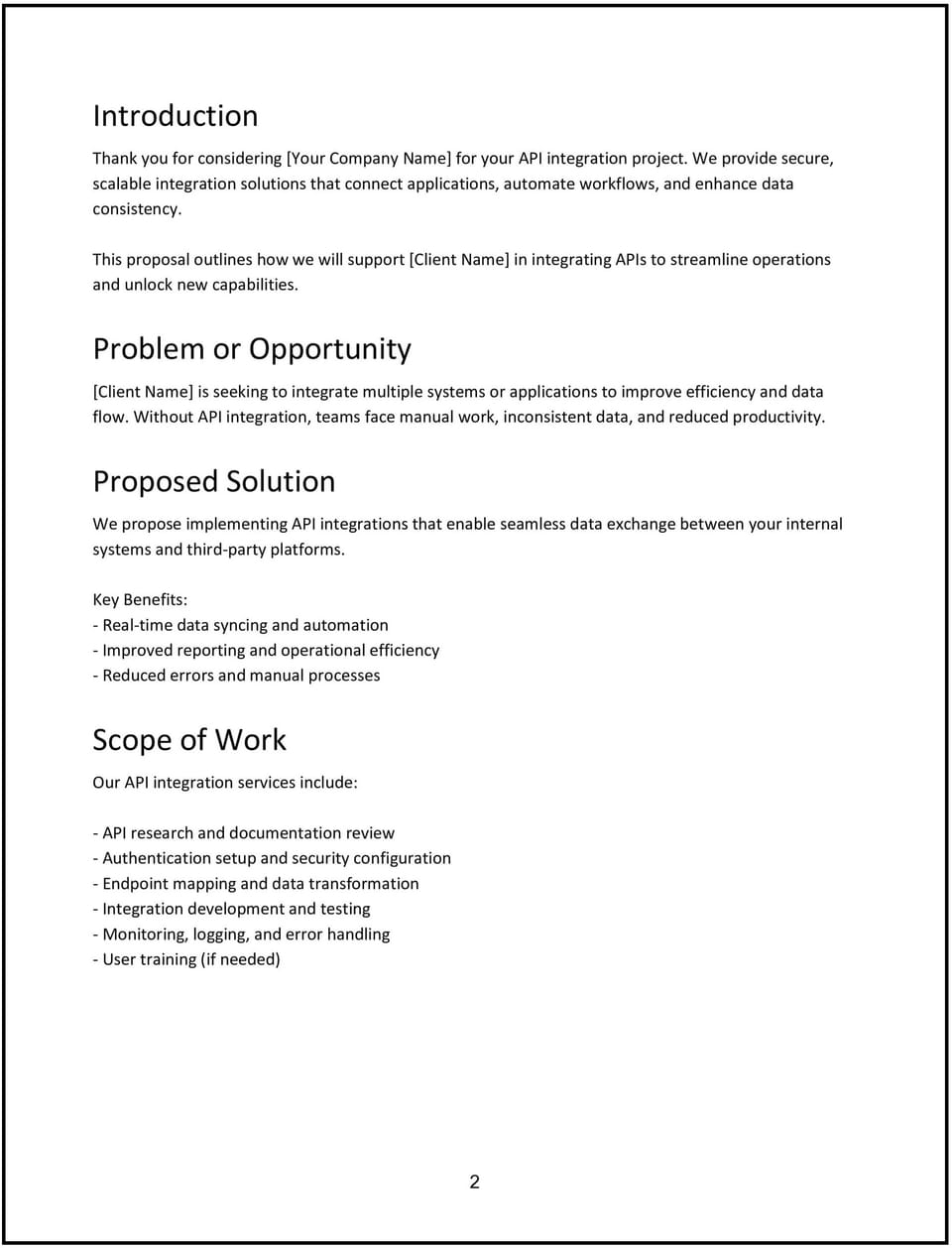API integration proposal: Free template

Customize this free API integration proposal with Cobrief
Open this free API integration proposal in Cobrief and start editing it instantly using AI. You can adjust the tone, structure, and content based on your technical scope, the client’s systems, and your integration approach. You can also use AI to review your draft — spot gaps, tighten language, and improve clarity before sending.
Once you're done, send, download, or save the proposal in one click — no formatting or setup required.
This template is fully customizable and built for real-world use — ideal for proposing third-party API integrations, internal system connections, or middleware solutions. Whether you're building SaaS integrations, backend connectors, or automation workflows, this version gives you a structured head start and removes the guesswork.
What is an API integration proposal?
An API integration proposal outlines how you’ll connect two or more systems using APIs (Application Programming Interfaces). It typically includes the purpose of the integration, supported endpoints, authentication method, data flow, tools used, and implementation plan.
This type of proposal is usually shared after initial discovery or technical assessment and helps clarify what data will be exchanged, how systems will communicate, and what the client can expect in terms of performance, reliability, and support.
A well-written API integration proposal helps you:
- Define the exact scope and endpoints to be integrated
- Set expectations around authentication, error handling, and testing
- Explain timelines, technical requirements, and dependencies
- Build trust with a structured and transparent implementation plan
Why use Cobrief to edit your proposal
Cobrief helps you move from idea to polished proposal — with AI built right into your editor.
- Edit the proposal directly in your browser: No formatting required — just start customizing.
- Rewrite sections with AI: Instantly improve clarity, simplify technical descriptions, or adjust tone.
- Run a one-click AI review: Spot vague or confusing sections and get recommendations to fix them.
- Apply AI suggestions instantly: Accept individual suggestions or apply all improvements with one click.
- Share or export instantly: Send the finished proposal via Cobrief or download a clean PDF or DOCX file instantly.
Cobrief helps you deliver professional, technical proposals faster — without the busywork.
When to use this proposal
Use this API integration proposal when:
- Proposing custom integrations between software platforms (e.g., CRM + billing system)
- Responding to RFPs involving third-party APIs
- Pitching automation solutions that require system-to-system communication
- Documenting integration plans as part of a broader development project
It works for REST, SOAP, GraphQL, and webhook-based integrations.
What to include in an API integration proposal
This structure helps your client understand the technical plan, timeline, and deliverables:
- Executive summary: Explain the goal of the integration — what systems are being connected and why. Focus on the business or operational benefit (e.g., reduce manual data entry, sync sales and support systems, automate customer workflows).
- Scope of work: Clearly define what will be built — endpoints to be used, type of data transferred, direction of data flow (one-way or bidirectional), and limits (e.g., no front-end work, no UI changes).
- Technical approach: Describe the APIs involved, authentication methods (e.g., OAuth, API keys), request/response format (e.g., JSON), and any middleware or automation tools used (e.g., Zapier, custom scripts, serverless functions).
- Timeline: Break the project into phases like discovery, development, testing, deployment, and documentation. Include approximate duration or milestone dates.
- Pricing: Present pricing clearly — hourly, per integration, or fixed-price packages. Mention optional costs like premium API access, platform fees, or support retainers.
- Terms and conditions: Include items like API rate limits, sandbox access, change requests, error handling policies, and SLA if applicable. Keep it readable and precise.
- Next steps: End with a confident CTA — like “Reply to confirm” or “Schedule a technical walkthrough.”
How to write an effective API integration proposal
This proposal should feel reliable, focused, and technically sound:
- Frame the problem clearly: Show how the integration saves time, reduces risk, or unlocks new functionality.
- Be specific about what’s included: Avoid scope creep by listing exact endpoints, workflows, and exclusions.
- Use plain-English explanations: Translate the technical plan into language clients can understand.
- Show your credentials: Mention past integration experience, relevant tools, or certifications.
- Format for clarity: Use bullets, subheadings, and short sections to make scanning easy.
- Close with direction: Provide a clear next step and keep the momentum going.
Frequently asked questions (FAQs)
Can I reuse this API integration proposal for different clients?
Yes — simply adjust the systems, endpoints, and scope for each integration.
Does this template support low-code/no-code integrations too?
It does — just describe the tools used (e.g., Zapier, Make, Tray.io) and clarify limitations.
Should I include diagrams?
Yes, if possible — a simple data flow diagram or system map can improve clarity.
Is this proposal legally binding?
No — this is a proposal. You can attach a master service agreement (MSA) or scope of work separately.
Can I export this as a PDF or DOCX file?
Yes — once edited, you can download it instantly in either format.
This article contains general legal information and does not contain legal advice. Cobrief is not a law firm or a substitute for an attorney or law firm. The law is complex and changes often. For legal advice, please ask a lawyer.